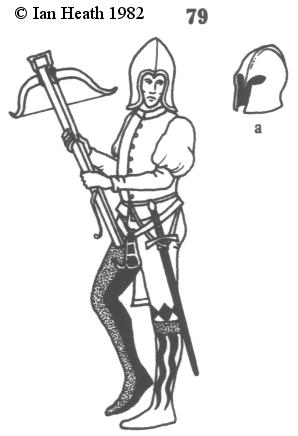|
|
ITALIAN CROSSBOWMAN
An extract from Armies of the Middle Ages, volume 1
by Ian Heath

79. ITALIAN CROSSBOWMAN c.1470
Uniforms were worn in Italy just as in England and France; in 1369, for example, Bernabo Visconti had a body of regular cavalry in red tunics and cloaks.
However, in Italy the uniforms were more varied and colourful because of the mercenary nature of Italian armies,
and many illustrations show quite small groups of foot-soldiers wearing hose which are patterned and coloured identically
(even though their actual tunics are not necessarily uniform).
A Sienese picture of 1468 depicting the members of a single mercenary lance being paid shows that even within this small a unit a livery or uniform was worn,
the sergeant and page of the lance being shown wearing identical colourful clothing,
even though the man-at-arms himself wears more sober civilian dress.
The fact that mercenary commanders actually considered their men's uniforms a matter of some importance is confirmed by the practice of having a third of his imprestanza (advance pay) made in cloth; for example, a Neapolitan contract of 1451 lists 1,100 cloths being provided, of which 350 were red, 250 each blue and green, 200 white and 50 purple.
Possibly each principal subcontracted mercenary group within a condottiere's command wore its own distinctive uniform.
Some Italian troops also wore badges - Sigismondo Malatesta's men, for example, wore the entwined initials I and S (S for Sigismondo,
I for his mistress Isotta), and Papal troops wore white keys.
Colleoni had a badge granted by Queen Joanna II of Naples which comprised a pair of lions' heads joined by a diagonal red on white band,
worn on breast and back over his white and red mi-parti livery.
The figure depicted here is actually a Florentine, from a painting of the Battle of Anghiari (1440).
He wears a type of barbute that was characteristic of the 15th century, while 79a shows a 'Corinthian' style barbute of a type that had gone out of use by c.1470.
Note the claw on his belt, Italian crossbowmen favouring the simple belt-and-claw mechanism for reloading in battle.
[Based on the Battle of Anghiari - unknown Florentine master]
|

